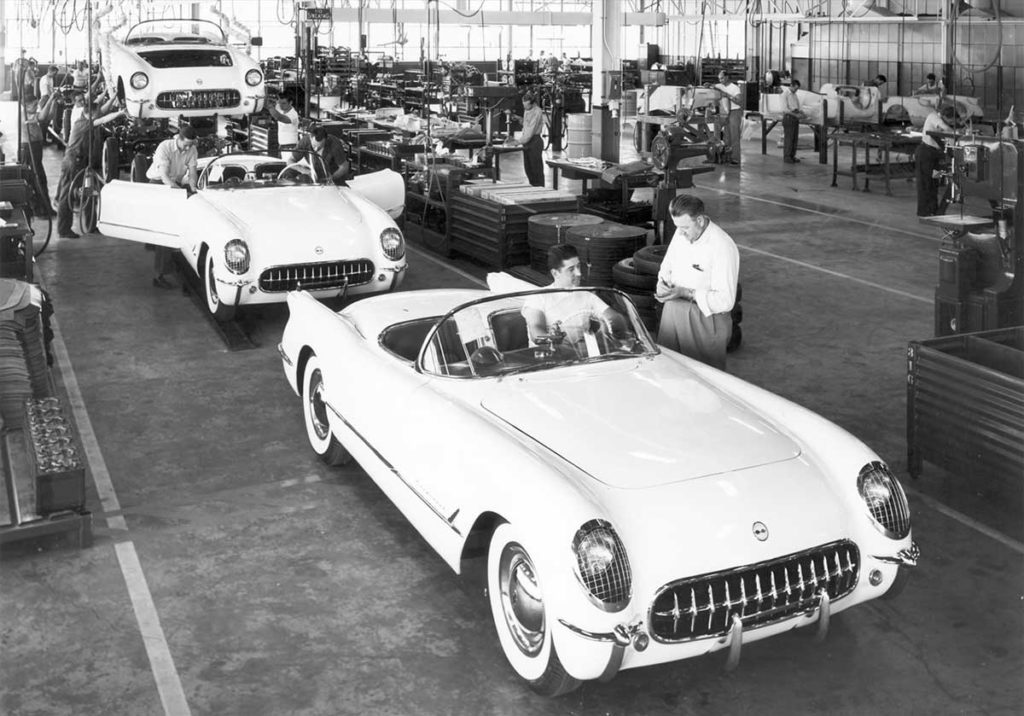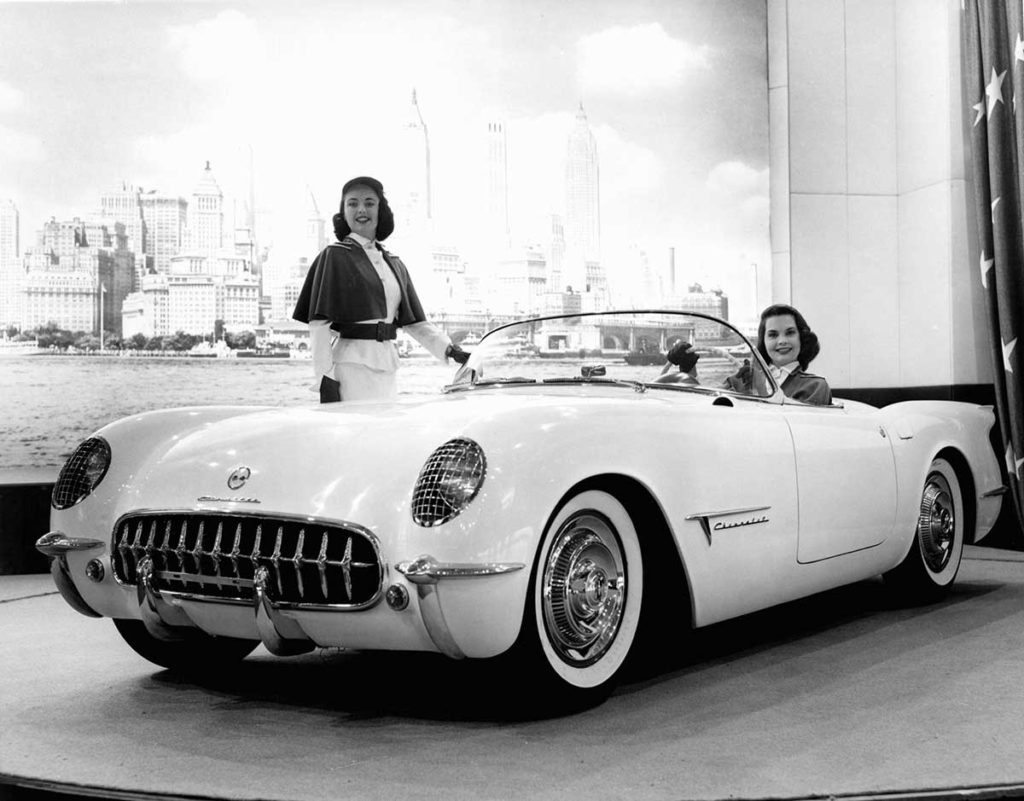
The first generation of Corvette was introduced late in the 1953 model year. Originally designed as a show car for the 1953 Motorama display at the New York Auto Show, it generated enough interest to induce GM to make a production version to sell to the public. First production was on June 30, 1953.
Pricing:
Convertible: $3498
Engine options:
235 – 3.9L, 6 cyl. – 150 HP (standard)
Units produced: 300
Top Speed: 105 MPH
Highlights of This Year:
Fiberglass Body, Mesh Stone Guarded Headlights, Vertical Grill Teeth, No Outside Door Handles, All Models were made in Polo White with Sportsman Red or White interiors and black tops, Each was essentially hand made, 5000 RPM Tachometer standard, Built-in exhaust outlets, 300 Units produced
Photos of the 1953 Corvette:



More about the 1953 Corvette:
The first generation of Corvette was introduced late in the 1953 model year. Originally designed as a show car for the 1953 Motorama display at the New York Auto Show, it generated enough interest to induce GM to make a production version to sell to the public. First production was on June 30, 1953.
From the start, the Chevrolet Corvette was truly unique. Based on the EX-122 concept of 1952, the Corvette remains one of the few GM Motorama designs with their space age, show-car styling virtually unmodified for production. Its highly anticipated early-1953 introduction in the ballroom of New York’s Waldorf-Astoria drew over 300,000 spectators, and production commenced in Flint, Michigan on June 30, 1953.
The response to the Motorama show car was overwhelmingly positive, and production began that June in Flint, Michigan. It would change the landscape of the American road forever.
The 1953 Corvettes were built by hand and appeared nearly identical to the Motorama car. They were powered by the existing Chevrolet 235-cu.-in. 6-cylinder engine that was modified with a three-carburetor design and dual exhaust to give it more sports car-like performance. Named the Blue Flame Special, this engine generated 150 horsepower, and it was teamed with a 2-speed Powerglide automatic transmission. This powertrain, however, did not live up to the performance expectations of sports car buyers.
As introduced in 1953, the Corvette was mostly a thrown together experiment. Production was limited to 300 units total, so sales of the entirely new model was not a problem.
The first Corvette reaches the end of the assembly line on June 30, 1953. The entire 1953 production took place in the back of a customer delivery garage in Flint Michigan. The first two were engineering test cars and according to official records, were destroyed. Of the first 300 Corvettes, approximately 225 are known to exist today.
Early 1953 Corvette wheel Notice the Chevrolet Bel Air wheel covers. According to GM, they were supplied on the first 25 Corvettes. The remaining production was equipped with the faux knock-off style. The same wheel continued thru 1957.
All 1953 Corvettes were Polo White with a red interior and a black canvas top. There were two options offered: a signal seeking AM radio ($145.15) and a heater ($91.40). Although listed as options, all 1953 Corvettes were equipped with both items. The base price was $3,498.00, including the federal excise tax and $248.00 for shipping and handling. The radio had an interesting feature: since fiberglass is electrically inert, the antenna was simply incorporated in the trunk lid. This would not be possible with a conventional steel body.
When introduced in 1953, the Corvette featured the “Blue Flame” six cylinder engine. This is not as the Chevrolet engineering team wanted things, but they had no choice. Although other GM marques featured V8 motors they were not willing to share; a very different situation compared to years later when various divisions would feature the same powerplants. It was renowned for reliability but with a rating of 105 HP, performance and sportiness was not included.
The engineering staff responded with the usual engine upgrade methods. A more radical camshaft rubbing on solid lifters, dual valve springs, and a higher compression ratio cylinder head (8.0:1; previous was 7.5:1) all contributed to the effort. The largest gain was achieved via an upgrade to the induction system. Three Carter type YH sidedraft carburetors featuring “bullet” air cleaners with an aluminum manifold were incorporated and the output soared to 150 bhp at 4,500 RPM.
Corvette headlights featured a stoneguard (or “fencing mask”) treatment, part of the “sports car” target image. They were often seen on race prepared cars as a way to prevent broken headlights from debris and rocks. The engineers and stylists both wanted glass covers, similar to what was used on the license plate but the current laws forbid the practice.
All 1953 Corvettes came with red interiors. A “waterfall” effect was found between the seats as a body piece extended into the interior. This gave a very open feeling to the car. Later generations would pay homage to this technique and incorporate the same design traits in the convertible models. Pressing the button released the convertible top cover.
The Corvette reputation as a performance car would have to wait until 1955 when a V8 became available. When equipped with the “Blue Flame” six cylinder, the zero to 60 time was around 11 seconds with 1/4 mile times of about 18 seconds. It’s hard to say which was more at fault; the six cylinder motor or the two speed automatic transmission.
The 1953 Corvette is probably better appreciated today than when it was new. There are two basic reasons why it will remain a desirable model amongst collectors: 1) 1953 was the first year of production, a strong point in collector car circles. 2) Limited production. At only 300 units it is by far the rarest Corvette model year.
All 1953-55 Corvettes had removable (as opposed to roll up/down) windows. Black oilcloth bags were used for storage. Along with the Polo White exterior, all 1953 Corvettes came with a black canvas soft top.
The 1953 thru 1957 Corvettes featured full instrumentation, which included oil pressure, battery, water temperature, fuel and tachometer. The bad news was that they were centrally located. The joke of the day was that the passenger had a better view of the tachometer. Bumpers, both front and rear, were purely decorative and offered no protection.
Despite what these official press photos may imply, hardtops were not an option supplied by Chevrolet. Aftermarket sources did supply them and in some cases they were sold by Chevrolet dealers. The fiberglass body was very labor intensive which explains the high purchase price. The tail light fin areas were particularly difficult to work with.
Sources
http://mobile.corvettestory.com/1953-corvette.php
http://www.boldride.com/ride/1953/chevrolet-corvette-roadster
https://en.wikipedia.org/wiki/Chevrolet_Corvette
Author
Evan Scronce // Contributor
